Common Internet Filesystem (CIFS) Backup and Restore
Common Internet Filesystem (CIFS) is useful for backing up file system types (such as Netware servers) that do not have Amanda Enterprise clients, or for when you do not wish to install the Zmanda client software on the system being backed up.
CIFS backup and recovery in Amanda Enterprise are performed using Samba (smbclient)
Like other file system backups, CIFS-based backup lets you specify files to exclude, and whether to enable encryption and compression. CIFS-based backup does not support backing up extended file attributes.
Using mount.cifs versus smbclient to Back Up CIFS Shares
There are two methods that Amanda can use to access a CIFS share for backup (neither of these require a Zmanda client on the machine being backed up):
- Add the share to mount.cifs on the Amanda client (which may be the same as the Amanda server). You can then back up the mounted share as a standard UNIX/Linux file system. This backup method cannot be used for performing incremental backups because amgtar backup of cifs shares do not retain inode numbers across mounts.
- Use smbclient (part of the Samba client package) to access the share using the System Message Block (SMB) protocol. This method is supported in Zmanda Management Console. This allows backup of Windows 3.1, Windows NT and older versions of Windows. As it uses the archive bit to identify files for incremental backup, other backup or archive programs that modify the archive bit will affect incremental backups (some files may not get backed up during incremental backups).
Neither method will back up NTFS extended file attributes or Windows applications. The Zmanda Windows Client (ZWC) is required to back up Windows applications and extended file attributes. To use the ZWC for backup, choose a Backup Type of Windows on the Backup What page.
Advantages and Disadvantages of mount.cifs/smbclient-based backup compared to installing the Zmanda Windows Client
Suppose you need to back up a number of Windows machine(s) over the WAN. The Amanda Enterprise backup server and Windows machines are connected through a firewall. You could use the client on the Amanda Enterprise server, adding firewall exceptions for the client machines you wish to back up. Restores are then performed to a directory on the AEE client (which is already shared via Samba).
Advantages
- Windows file system can be backed up without having to install Zmanda software on the client.
- Once the firewall ports have been opened for Samba, no further firewall ports need to be opened.
- Simplified restore process.
Disadvantages
- Restore to original along with Windows ACL and Attributes is not possible.
Requirements for CIFS Server Backup and Restore
These instructions assume you have already installed and licensed the Amanda Enterprise server.
- Create a backup set that you intend to use for backing up the CIFS share as described here.
- Please make sure you have read and implemented necessary configuration steps on the Amanda client.
- Amanda assumes that the smbclient executable binary file is located on the Amanda client in /usr/bin. If smbclient is not in /usr/bin, create a symbolic link to the file in that directory. Alternatively, you can edit
/etc/zmanda/zmc_aee/zmc_user_dumptypes
on the Amanda server (make a safe backup copy before doing so). Find the application tool definition for app_amsamba_user and add the following property:
property "SMBCLIENT-PATH" "Path_to_smbclient_Binary"
Path_to_smbclient_Binary
The path to the smbclient binary executable file.
Example entry:
property "SMBCLIENT-PATH" "/usr/csw/bin"
Configuring CIFS Backups from the ZMC Backup What Page
On the Backup What page you are prompted to select what type of object you want to back up. Choose Filesystem > CIFS, and the following options are displayed:
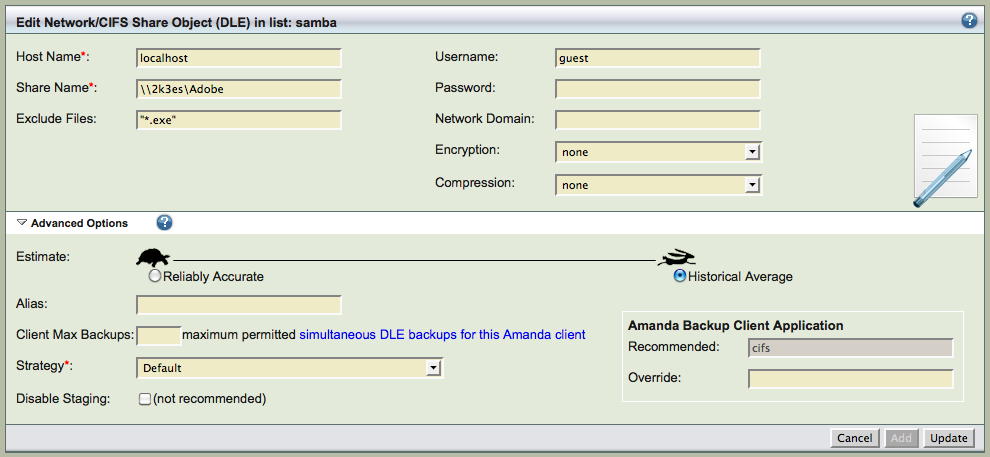
- Host Name
-
The host name of Amanda client. For better backup performance, Zmanda recommends using the Amanda server itself (specified as localhost) as the Amanda client. smbclient (part of the Samba client package) must be installed on the Amanda client or the Amanda server if Amanda server is used as the host.
If a remote Amanda client is used (in other words, a client other than localhost) you must create the /etc/amanda/backup_set_name/cifs_network_shares file on the Amanda client. You can copy this file from the version that the ZMC creates on the server: /etc/amanda/backup_set_name/cifs_network_shares.client_name. Alternatively, the authentication file can be stored in /etc/amanda/cifs_network_shares.
The cifs_network_shares file must be owned and readable by the Amanda backup user, and it must contain an entry for CIFS share being backed up in form \\Host_IP\backup_set_name root%password. For example: 192.168.15.127 is the CIFS server.
\\192.168.15.127\aee_backup root%boot12
- Share Name
-
The CIFS share represented in \\CIFSserver\share\sub-directory format (in other words, the Univeral Naming Convention - UNC format). The CIFSserver can be specified by host name or IP address. This is the share backed up by Amanda as a backup object.
.png)
Recommended CIFS Backup Configuration - Username
-
User name used to access the SMB share.
- Password
- Password required for the user; please note the password is displayed in plain text as it is typed.
- Network Domain
-
CIFS server domain name. To find it, open a command window on the Amanda client or the Amanda server and enter the following command:
smbclient -L IP_of_Amanda_client -U smb_usernamefrom the Windows client. You will be prompted for the SMB password.
- Exclude Files
- Lists files to be excluded from the backup. Regular expressions and wildcards (such as * and ?) are not allowed. All expressions are matched only from the base directory of the DLE. Expressions that match a directory may have a leading or trailing "/".
- Encryption & Compression Options
- Lists Encryption and Compression choices. Encryption and Compression of data is described here.
- Advanced Options - Estimate
- If estimates are taking too long and the databases being backed up do not change in size that much from backup to backup, use the the Historical Average calculated from previous backups. In most cases, the default of Reliably Accurate is appropriate.
After you have set the options, click the Add/Update button to add the CIFS share to the backup set. You can then configure the backup set just as you would any other by setting the options on Backup Where, Backup How, and Backup When, etc.
Restoring CIFS share backup
You can use ZMC Restore pages to restore CIFS shares that were backed up using cifs application (which uses smbclient command). Similar restore operations can be performed using amrecover(8) command.
Select the backup images that have to be restored by selecting the backup timestamp, name of CIFS share and the host name. The host name is usually localhost (i.e, Amanda server itself). The name of CIFS share is specified as \\<cifs server>\directory format as shown below. You can use Express restore to restore the whole backup image or use Explore & Select to select specific files/directory for restoration.
For restoration to work, the CIFS share user authentication information must be added to the /etc/amanda/cifs_network_shares configuration file on the Amanda server
The cifs_network_shares file must be owned and readable by the amandabackup user, and it must contain an entry for CIFS share being backed up in form \\Host_IP\backup_set_name root%password. For example: 192.168.15.127 is the CIFS server.
\\192.168.15.127\aee_backup root%boot12
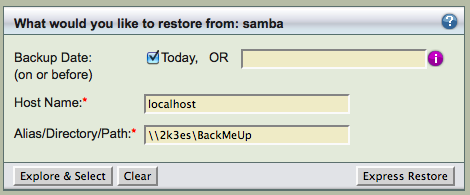
You can restore the complete backup image using Express Restore or selectively restore CIFS share files using Explore & Select button. Selective restoration of files can be done when restoration is done to original CIFS share or an alternate CIFS share. If you are restoring to UNIX/Linux client directory (including Amanda server), selective restoration is not possible (all files in the backup image will be restored).
After selecting what to restore, you can specify where to restore the backups to in the Restore Where page. You can either restore to original or different CIFS share or to the Amanda server. You can also specify conflict resolution settings. The following picture shows restoration to a (Destination Sharename) directory /root/recovered on the Amanda server.
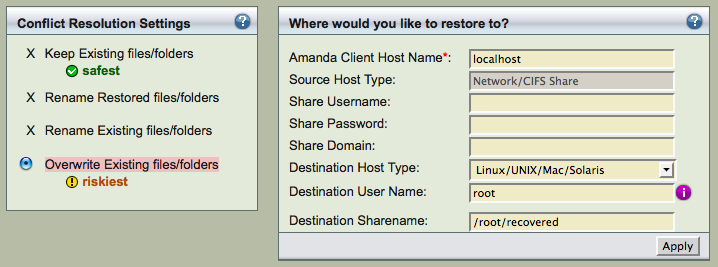
If you are restoring to original or different CIFS share, you will have to provide Share user, password and domain information so that data can be written to the share. The user should have write permissions for the share. The Destination Sharename should be in \\<cifs server name>\sharename format as shown below. You must restore back to a CIFS share and not a sub-directory of a CIFS share.
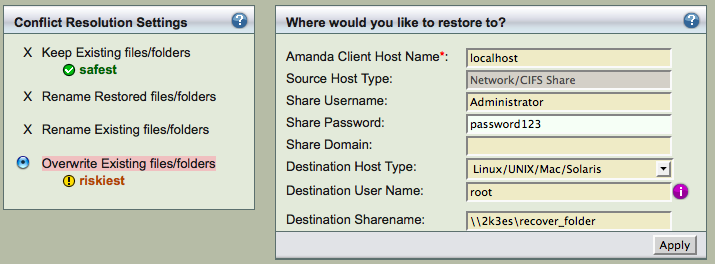
You can start the restore process on the ZMC Restore Restore page after reviewing the job parameters as shown below
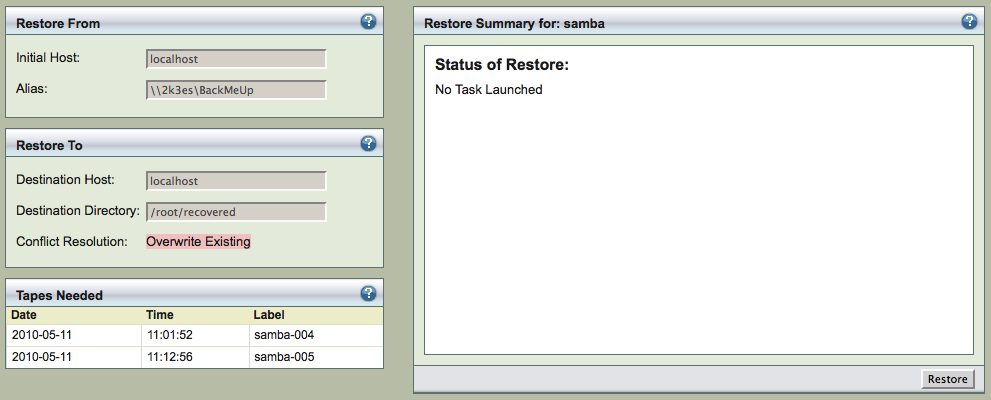
The Restore Restore page shows the list of tapes or vtapes that will be used in the restore process.
